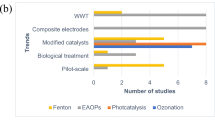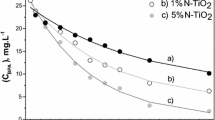Abstract
The photoelectrocatalytic (PEC) degradation of 4-nonylphenol ethoxylate (NP4EO) using a low, moderate, or high UV photon flux in different treatment times was investigated. The byproducts were verified using gas chromatography with flame ionization detection (GC-FID) and gas chromatography with quadrupole mass analyzer (GC-qMS). The GC results showed that the use of a low (2.89 μmol m−2s−1) or a high (36.16 μmol m−2s−1) UV photon flux reaching the anode surface was associated to the production of alcohols and the toxic byproduct nonylphenol (NP), leading to the same degradation pathway. Meanwhile, the use of a moderate UV photon flux (14.19 μmol m−2s−1) reaching the anode surface did not produce alcohols or the NP toxic byproduct. This study demonstrates that different UV photon fluxes will have an influence in the degradation of NP4EO with or without generation of toxic byproducts. Furthermore, it is concluded that, after the determination of the UV photon flux able to degrade NP4EO without NP formation, the treatment time is essential in removal of NP4EO, since increasing the treatment time of 4 to 10 h, when using the PEC best conditions (moderate UV photon flux), implies in a higher treatment efficiency.







Similar content being viewed by others
References
Ahel M, Conrad T, Giger W (1987) Persistent organic chemicals in sewage effluents 3: determinations of nonylphenoxy carboxylic acids by high-resolution gas chromatography/mass spectrometry and high-performance liquid chromatography. Environ Sci Technol 21:697–703
Augugliaro V, Loddo V, Palmisano I, Schiavello M (1995a) Performance of heterogeneous photocatalytic systems; influence of operational variables on photoactivity of aqueous suspension of TiO2. J Catal 153:32–40
Augugliaro V, Loddo V, Palmisano I, Schiavello M (1995b) Heterogeneous photocatalytic systems: influence of some operational variables on actual photons absorbed by aqueous dispersions of Ti02. Sol Energ Mater Sol C 38:411–419
Benner J, Helbling DE, Kohler H-PE, Wittebol J, Kaiser E, Prasse C, Ternes TA, Albers CN, Aamand J, Horemans B, Springael D, Walravens E, Boon N (2013) Is biological treatment a viable alternative for micropollutant removal in drinking water treatment processes? Water Res 47:5955–5976
Braga O, Smythe GA, Schäfer AI, Feitz AJ (2005) Steroid estrogens in ocean sediments. Chemosphere 61:827–833
Camacho-Munoz D, Martin J, Santos JL, Alonso E, Aparicio I, De la Torre T, Rodriguez C, Malfeito JJ (2012) Effectiveness of three configurations of membrane bioreactors on the removal of priority and emergent organic compounds from wastewater: comparison with conventional wastewater treatments. J Environ Monit 14:1428–36
Chang LL, Wun WS, Wang PS (2012) In utero and neonate exposure to nonylphenol develops hyperadrenalism and metabolic syndrome later in life. I. First generation rats (F(1)). Toxicology 301:40–9
Choi KJ, Kim SG, Kim CW, Park JK (2006) Removal efficiencies of endocrine disrupting chemicals by coagulation/flocculation, ozonation, powdered/granular activated carbon adsorption, and chlorination. Korean J Chem Eng 23:399–408
Choi M, Furlong ET, Moon HB, Yu J, Choi HG (2011) Contamination of nonylphenolic compounds in creek water, wastewater treatment plant effluents, and sediments from Lake Shihwa and vicinity, Korea: comparison with fecal pollution. Chemosphere 85:1406–13
Chu W, Wong CC (2004) The photocatalytic degradation of dicamba in TiO2 suspensions with the help of hydrogen peroxide by different near UV irradiations. Water Res 38:1037–1043
da Silva SW, Bordignon GL, Viegas C, Rodrigues MAS, Arenzon A, Bernardes AM (2015a) Treatment of solutions containing nonylphenol ethoxylate by photoelectrooxidation. Chemosphere 119(Supplement):S101–S108
da Silva SW, Klauck CR, Siqueira MA, Bernardes AM (2015b) Degradation of the commercial surfactant nonylphenol ethoxylate by advanced oxidation processes. J Hazard Mater 282:241–248
EPA (2014) United States Environmental Protection Agency., http://www2.epa.gov/oppt/existingchemicals/pubs/actionplans/np-npe.html#previous, access in 2015
Esperanza M, Suidan MT, Nishimura F, Wang ZM, Sorial GA, Zaffiro A, McCauley P, Brenner R, Sayles G (2004) Determination of sex hormones and nonylphenol ethoxylates in the aqueous matrixes of two pilot-scale municipal wastewater treatment plants. Environ Sci Technol 38:3028–3035
Frassinetti S, Barberio C, Caltavuturo L, Fava F, Di Gioia D (2011) Genotoxicity of 4-nonylphenol and nonylphenol ethoxylate mixtures by the use of Saccharomyces cerevisiae D7 mutation assay and use of this text to evaluate the efficiency of biodegradation treatments. Ecotoxicol Environ Saf 74:253–8
Gerolin ERR (2008) Ocorrência e remoção de disruptores endócrinos em águas utilizadas para abastecimento público de Campinas e Sumare – SP. Doutorado Thesis, Universidade Estadual De Campinas, http://www.bibliotecadigital.unicamp.br/document/?code=000436059
González MM, Martín J, Santos JL, Aparicio I, Alonso E (2010) Occurrence and risk assessment of nonylphenol and nonylphenol ethoxylates in sewage sludge from different conventional treatment processes. Sci Total Environ 408:563–570
Guedez AA, Frommel S, Diehl P, Puttmann W (2010) Occurrence and temporal variations of TMDD in the river Rhine. Germany Environ Sci Pollut Res 17:321–30
He F, Niu L, Aya O, Wang S, Wang L (2013) Occurrence and fate of nonylphenol ethoxylates and their derivatives in Nansi Lake environments. China Water Environ Res 85:27–34
Höhne C, Püttmann W (2008) Occurrence and temporal variations of the xenoestrogens bisphenol A, 4-tert-octylphenol, and tech. 4-nonylphenol in two German wastewater treatment plants. Environ Sci Pollut Res 15:405–416
Kammann U, Vobach M, Wosniok W, Schäffer A, Telscher A (2009) Acute toxicity of 353-nonylphenol and its metabolites for zebrafish embryos. Environ Sci Pollut Res 16:227–231
Karci A, Arslan-Alaton I, Bekbolet M, Ozhan G, Alpertunga B (2014) H2O2/UV-C and photo-Fenton treatment of a nonylphenol polyethoxylate in synthetic freshwater: follow-up of degradation products, acute toxicity and genotoxicity. Chem Eng J 241:43–51
Kim SD, Cho J, Kim IS, Vanderford BJ, Snyder SA (2007) Occurrence and removal of pharmaceuticals and endocrine disruptors in South Korean surface, drinking, and waste waters. Water Res 41:1013–1021
Konstantinou IK, Albanis TA (2004) TiO2-assisted photocatalytic degradation of azo dyes in aqueous solution: kinetic and mechanistic investigations: a review. Appl Catal Environ 49:1–14
Lee C-C, Jiang L-Y, Kuo Y-L, Chen C-Y, Hsieh C-Y, Hung C-F, Tien C-J (2015) Characteristics of nonylphenol and bisphenol A accumulation by fish and implications for ecological and human health. Sci Total Environ 502:417–425
Lian J, Liu JX (2012) Fate analysis of NPEOs and their metabolites in municipal wastewater plants. Huan Jing Ke Xue 33:3295–300
Liu B, Zhao X (2010) A kinetic model for evaluating the dependence of the quantum yield of nano-TiO2 based photocatalysis on light intensity, grain size, carrier lifetime, and minority carrier diffusion coefficient: Indirect interfacial charge transfer. Electrochim Acta 55:4062–4070
Moreira DS (2008) Desenvolvimento de metodologia analítica por cromatografia/espectrometria de massas para avaliação da ocorrência de perturbadores endócrinos em mananciais de abastecimento da região metropolitana de Belo Horizonte. Mestrado Thesis, Universidade Federal de Ouro Preto, http://www.repositorio.ufop.br/handle/123456789/2188
Neamţu M, Frimmel FH (2006) Photodegradation of endocrine disrupting chemical nonylphenol by simulated solar UV-irradiation. Sci Total Environ 369:295–306
Ning B, Graham NJD, Zhang Y (2007a) Degradation of octylphenol and nonylphenol by ozone—Part II: indirect reaction. Chemosphere 68:1173–1179
Ning B, Graham NJD, Zhang Y (2007b) Degradation of octylphenol and nonylphenol by ozone—Part I: direct reaction. Chemosphere 68:1163–1172
Noutsopoulos C, Mamais D, Samaras V, Bouras T, Marneri M, Antoniou K (2013) Effect of wastewater chlorination on endocrine disruptor removal. Water Sci Technol 67:1551–6
Ohtani B (2011): Chapter 10—Photocatalysis by inorganic solid materials: revisiting its definition, concepts, and experimental procedures. In: Rudi van E, Grażyna S (Editors), Adv. Inorg. Chem. Academic Press, pp. 395-430
Philips (2015) HPL high pressure mercury, http://www.lighting.philips.com/main/prof/lamps/high-intensity-discharge-lamps/hpl-high-pressure-mercury/hpl-n/productsinfamily. Accessed in 2015
Reis AR, Tabei K, Sakakibara Y (2014) Oxidation mechanism and overall removal rates of endocrine disrupting chemicals by aquatic plants. J Hazard Mater 265:79–88
Ribeiro AR, Nunes OC, Pereira MFR, Silva AMT (2015) An overview on the advanced oxidation processes applied for the treatment of water pollutants defined in the recently launched Directive 2013/39/EU. Environ Inter 75:33–51
Rima J, Assaker K (2012) Remediation of 4-nonylphenol in aqueous solution by using free radicals generated by the oxidative reactions. Environ Sci Pollut Res 19:2038–2043
Sherrard KB, Marriott PJ, Amiet RG, McCormick MJ (1996) Spectroscopic analysis of heterogeneous photocatalysis products of nonylphenol- and primary alcohol ethoxylate nonionic surfactants. Chemosphere 33:1921–1940
Stottmeister E et al (2009) Interlaboratory trial on the analysis of alkylphenols, alkylphenol ethoxylates, and bisphenol A in water samples according to ISO/CD 18857-2. Anal Chem 81:6765–73
Vega-Morales T, Sosa-Ferrera Z, Santana-Rodriguez JJ (2010) Determination of alkylphenol polyethoxylates, bisphenol-A, 17alpha-ethynylestradiol and 17beta-estradiol and its metabolites in sewage samples by SPE and LC/MS/MS. J Hazard Mater 183:701–11
Vega-Morales T, Guedes-Alonso R, Sosa-Ferrera Z, Santana-Rodriguez JJ (2012) Determination and assessment of estradiol-mimicking compounds in the dissolved and particulate phases of wastewater treatment plant samples. J AOAC Int 95:1195–204
Villarreal TL, Gómez R, González M, Salvador P (2004) A kinetic model for distinguishing between direct and indirect interfacial hole transfer in the heterogeneous photooxidation of dissolved organics on TiO2 nanoparticle suspensions. J Phys Chem B 108:20278–20290
Yu Y, Zhai H, Hou S, Sun H (2009) Nonylphenol ethoxylates and their metabolites in sewage treatment plants and rivers of Tianjin, China. Chemosphere 77:1–7
Zhang Q, Li C, Li T (2012) Rapid Photocatalytic Degradation of Methylene Blue under High Photon Flux UV Irradiation: Characteristics and Comparison with Routine Low Photon Flux. Int. J. Photoenergy 1–7
Acknowledgments
The authors would like to acknowledge the Brazilian financial support from CNPq, FAPERGS, FINEP, and CAPES.
Author information
Authors and Affiliations
Corresponding author
Additional information
Responsible editor: Vítor Pais Vilar
Rights and permissions
About this article
Cite this article
da Silva, S.W., Viegas, C., Ferreira, J.Z. et al. The effect of the UV photon flux on the photoelectrocatalytic degradation of endocrine-disrupting alkylphenolic chemicals. Environ Sci Pollut Res 23, 19237–19245 (2016). https://doi.org/10.1007/s11356-016-7121-3
Received:
Accepted:
Published:
Issue Date:
DOI: https://doi.org/10.1007/s11356-016-7121-3




